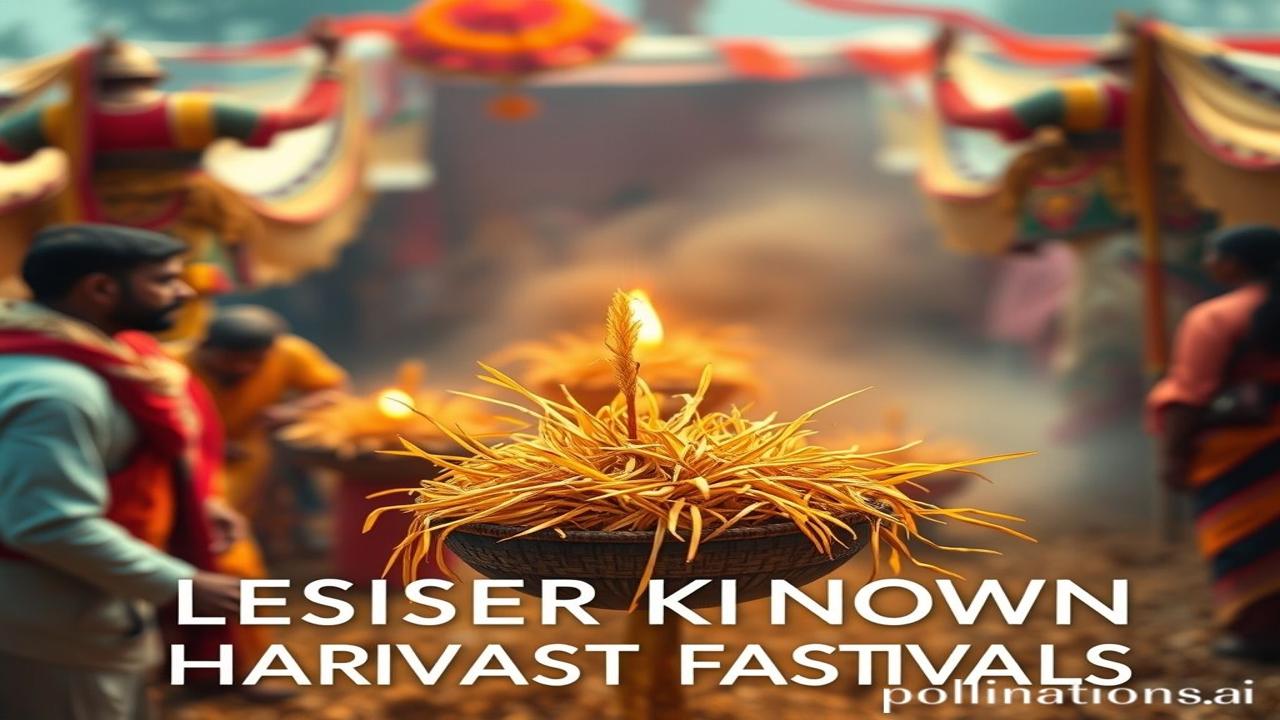Waqt Ki Dhool Mein Dabi Khushiyon Ki Mehfil: Unsung Harvest Festivals of India
Kabhi socha hai, jo anaj hum roz khaate hain, uske pichhe kitni kahaniyan dabi hain? Hum Diwali aur Holi toh dhoom-dhaam se manate hain, lekin Bharat ki dharti par aise kitne hi fasal parv hain jo waqt ki dhool mein kahin kho gaye hain. Aaiye, aaj hum unhi bhooli-bisri khushiyon ki mehfil mein shamil hote hain. Chaliye, delve into the lesser-known, but equally vibrant, regional harvest festivals of India.
Fasal Katne Ka Jashn: What, When, Where, and Why?
India, being an agricultural country, has always celebrated the harvest season. These festivals are not just about cutting crops; they are about giving thanks to Mother Earth for her bounty. They’re about community, family, and the cycle of life itself. These festivals often mark the end of the agricultural cycle and the beginning of a new one, promising hope and prosperity.
While festivals like Baisakhi (Punjab), Pongal (Tamil Nadu), and Makar Sankranti (pan-India) are well-known, there are numerous regional harvest festivals tucked away in different corners of the country. They often feature unique rituals, local delicacies, and vibrant folk performances. These festivals offer a glimpse into the specific agricultural practices and cultural traditions of each region. Think of them as micro-celebrations of a universal theme: gratitude for a bountiful harvest.
Dharti Maa Ki Puja: A Glimpse into Daily Life
Imagine a village in Chattisgarh, a few centuries ago. The air is thick with the scent of freshly harvested rice. Women, adorned in colorful sarees, are busy decorating the courtyards with intricate rangolis made of rice flour. The men are preparing for the Cher-Chera festival. The rhythmic beat of dholaks echoes through the air as villagers gather to offer the first harvest to the village deity, Dharti Maa.
“Aaj to sab kuchh Dhan Lakhmi maa ne diya hai!” exclaimed an old farmer, his eyes filled with gratitude, as he placed a handful of rice at the foot of the deity’s idol. “Agli baar bhi ashirvad dena, maa!” Ma Rukmini, the village’s most respected woman, prepares pitha (rice cakes) and laddoos from the new harvest, symbolizing prosperity and abundance. Children run around, their faces smeared with colored powders, singing folk songs passed down through generations. This is the essence of Cher-Chera: a celebration of community, gratitude, and the simple joys of life.
Similarly, in a remote corner of Odisha, the Nuakhai festival unfolds. Families gather to offer the first grains of the new rice crop to their presiding deities. It’s a day for mending broken relationships, forgiving old grudges, and starting afresh. The air is filled with the aroma of freshly cooked rice and the sounds of traditional Odissi music.
Aaj Kal Ki Bharatiyata: Cultural Significance Today
Even today, in the age of technology and globalization, these lesser-known harvest festivals continue to hold cultural significance. They serve as a reminder of our deep connection to the land and the importance of preserving our agricultural heritage. While the scale of celebrations may have diminished in some areas, the core values of gratitude, community, and respect for nature remain intact.
We see echoes of these traditions in the way many Indian families still conduct rituals related to food and agriculture. The act of offering the first cooked meal to the gods or ancestors is a common practice, reflecting a deep-seated reverence for the source of our sustenance. The spirit of Bharatiyata lies in recognizing and celebrating these diverse expressions of our cultural heritage.
Myth-Buster: Harvest Festivals are Only for Farmers?
Log samajhte hain ki ye fasal parv sirf kisanon ke liye hain. Lekin asli sach yeh hai ki ye tyohar poore samaj ko ek saath laate hain. Artisans, traders, and even rulers participate in the celebrations, recognizing the importance of agriculture in the overall well-being of the community. These festivals are a testament to the interconnectedness of society and the shared dependence on the land.
Aankhon Dekhi, Dil Se Mehsoos: Visual and Sensory Journey
Imagine walking through a village during Cher-Chera. The air smells of woodsmoke and freshly baked pitha. The sound of dholaks fills your ears, and the colorful rangolis catch your eye. You can feel the warmth of the sun on your skin and the smiles of the villagers as they share their food and stories. The temple walls, weathered by time, stand as silent witnesses to generations of celebrations. It’s a sensory feast that immerses you in the heart of rural India.
Antim Vichar: A Reflection on the Rhythms of Life
These lesser-known harvest festivals are not just about celebrating a successful harvest; they are about celebrating life itself. They remind us to appreciate the simple things, to be grateful for what we have, and to cherish the bonds that connect us.
“Krishi sanskruti, jeevan darshan” – Agriculture is not just cultivation; it’s a way of life, a philosophy that teaches us to live in harmony with nature. Let’s strive to keep these traditions alive, not just as relics of the past but as vibrant expressions of our Bharatiya identity.
